Power Up Your Knowledge: Essential Safety Precautions before Starting an Electric Motor
Electric motors are a powerhouse of energy, converting electrical energy into mechanical energy. But with great power comes great responsibility, and starting an electric motor can be a dangerous task if not done correctly. The safety of operators and equipment is paramount when working with electric motors, and taking proper precautions is key to avoiding potential accidents.
In this blog post, we’ll explore the best practices for starting electric motors safely, including some basic steps, tips, and techniques to ensure smooth and secure operation. With the right knowledge and training, you can start an electric motor safely and avoid potential hazards, so let’s get started.
Understand the Hazards
Before starting an electric motor, it is crucial to understand the hazards involved. One safety precaution required is to wear personal protective equipment, including gloves, safety glasses, and proper clothing. It is also essential to ensure that the motor is correctly grounded and that all electrical connections are secured.
In addition, a thorough inspection of the motor and its surroundings must be conducted to prevent any potential hazards, such as obstructions or flammable materials. Always be mindful of the motor’s power source by disconnecting or locking out any switches or circuits before starting. By taking these necessary precautions, you can minimize the risks and ensure a safe working environment.
Identify Electrical Hazards
Electrical hazards are present in almost every aspect of modern life. From the power outlets in our homes to the electrical equipment used in industries, the risks of electrocution, burns, and fires are ever-present. It is essential to understand the hazards associated with electricity to prevent accidents and protect ourselves and others.
One major hazard is the risk of electrical shock or electrocution, which can occur when the body comes into contact with an electrical current. This can be especially dangerous if the current is strong enough to cause muscle spasms or throw the victim away from the source of the current. Burns are also a major risk in electrical accidents, which occur when the body comes into contact with a high voltage current or with a metal object that has heated up due to the current.
Another significant risk is the potential for electrical fires, which can result from faulty wiring, overloaded circuits, or damaged electrical appliances. By identifying the hazards associated with electricity, we can take steps to mitigate the risks and ensure everyone’s safety.

Recognize Physical Hazards
As someone working in hazardous conditions, it is essential to be aware of the various types of physical hazards you could encounter. Understanding these hazards is crucial to prevent accidents and maintain a safe working environment. The three main types of physical hazards are mechanical, electrical, and radiation.
Mechanical hazards can include slipping on wet surfaces, getting struck by objects, or being caught in machinery. Electrical hazards are associated with exposed wires, high-voltage equipment, and damaged electrical cords. Radiation hazards can be caused by exposure to X-rays, ultraviolet light, and radioactivity.
All of these hazards can cause serious injuries or even death if not recognized and properly controlled. So, it is vital to be vigilant and take necessary precautions to avoid them. Remember, prevention is always better than cure.
Inspect the Equipment
What safety precaution is required before starting an electric motor? Before starting an electric motor, it is important to inspect the equipment to ensure that it is in good working condition. This includes checking that all electrical connections are secure, there are no frayed wires or damaged cables, and that the motor is free from any physical damage. It is also important to ensure that any safety guards, covers or shields are in place and operational.
Additionally, you should ensure that the motor is properly grounded, as this prevents the risk of electrical shock or short circuiting. By taking these safety precautions, you can help to prevent accidents or injuries that could occur due to a malfunctioning motor. Remember, safety always comes first when dealing with electrical equipment, so take your time, follow the necessary procedures, and always exercise caution when starting an electric motor.
Inspect for Damage
Inspecting the equipment is an essential step to ensure safety and functionality. Before starting your equipment, always take a few minutes to inspect it for any damage. Check all parts and connections thoroughly.
Look for any cracks or rust on the body and inspect all the moving parts for wear and tear. If you notice any suspicious damage, do not attempt to operate the equipment. Depending on the type of equipment, a damaged part can lead to serious safety risks or cause further damage to the machine.
Remember, it is always better to be cautious than to risk your safety or the functionality of your equipment. By checking for any damage regularly, you will also be able to catch any issues early, which will save you money in the long run. A little extra time spent inspecting your equipment can go a long way towards ensuring safety and longevity.
Verify Proper Grounding
When inspecting electrical equipment, one important step to take is to verify proper grounding. This is essential for ensuring the safety of those who work with or near the equipment. To do this, you’ll want to check the grounding conductor to make sure it’s properly connected to the equipment and that it’s not damaged.
You should also check for any signs of overheating or corrosion on the grounding conductor or the grounding bus. Additionally, you’ll want to verify that the electrical system has a grounding electrode system that meets the requirements of the National Electrical Code (NEC). By taking the time to inspect the equipment for proper grounding, you can help prevent electrical shocks, fires, and other hazards that can be caused by faulty electrical systems.
It’s important to remember that electrical safety is everyone’s responsibility, and properly grounding electrical equipment is just one small but critical step in ensuring that everyone stays safe.
Prepare for Start-Up
Before starting an electric motor, it is important to take certain safety precautions to ensure the safety of yourself and others around you. First, ensure that the motor is properly grounded to prevent electrical shocks. Additionally, make sure the motor is properly installed and secured to prevent any accidents or damage caused by improper handling.
It is also important to check the motor for any signs of wear or damage, such as frayed wires or loose connections, before starting it. Another safety precaution to take is to use the proper Personal Protective Equipment (PPE), such as safety glasses or gloves, to protect against any potential hazards. By taking these safety precautions before starting an electric motor, you can help ensure the safety of everyone involved and prevent any unnecessary accidents or damage.
Remember, safety should always come first when it comes to dealing with electric motors.
Use Proper Personal Protective Equipment
Preparing for start-up of any workplace requires careful consideration of safety. One of the most important components of this process is ensuring that everyone has the proper personal protective equipment (PPE) before beginning work. PPE is essential for the safety of each workforce member and must be worn when they need to perform tasks that could cause injury or illness.
Examples of PPE include safety goggles, hard hats, gloves, earplugs, and respirators. Depending on the job’s nature, the specific PPE required can differ, so it’s important to do an assessment of the job’s hazards before ensuring everyone has the correct gear needed. By making sure all employees have the correct PPE, you can take a critical step in maintaining their safety and consistent production while keeping in line with industry safety guidelines.
Secure the Work Area
When it comes to starting up a work area, it’s important to take the necessary steps to ensure safety and security. One crucial part of that process is preparing the work area for start-up. This involves a variety of tasks, from ensuring all equipment is in good working order to checking for potential hazards and taking steps to mitigate them.
Additionally, it’s essential to ensure that all workers are properly trained in safety procedures and are aware of the potential risks associated with their job. By taking these steps, you can help to minimize the risk of accidents and injuries in the work area, and create a secure and safe environment for your employees to work in. Remember to keep in mind the importance of pre-planning and being proactive in your approach to workplace safety, as it can make all the difference in preventing accidents and injuries from occurring.
Start the Motor Carefully
Before starting an electric motor, it is crucial to take some safety precautions to avoid accidents or injuries. One of the most important things to remember is to start the motor carefully. You should double-check that all the connections are secure and that the motor is free from any obstructions or potential hazards.
Additionally, you should always make sure that the power source to the motor is properly grounded and that you are using the correct voltage. It is also recommended to wear personal protective equipment, such as gloves and eye protection, when handling the motor. By taking these safety precautions, you can ensure that the motor starts smoothly and safely.
Remember, safety should always be your top priority when working with electric motors.
Follow Manufacturer’s Instructions
If you want to ensure a long life for your motor, start it carefully by following the manufacturer’s instructions. This is the best way to avoid any potential damage to the motor, and it will also help prevent any accidents or injuries. Be sure to read the manual carefully before you start the motor, and follow all of the safety instructions provided.
This may include wearing protective gear, checking for any leaks or damage before starting the motor, and ensuring that the area around the motor is clear of any obstacles or hazards. By taking these precautions, you can help ensure that your motor runs smoothly and safely for years to come. So, whether you’re using your motor for recreational activities or for work, always remember to start it carefully and follow the manufacturer’s instructions.
Conclusion
Before starting an electric motor, it is vital to make sure you don’t become the newest member of the “shocking experience” club. By taking the necessary safety precautions such as wearing insulated gloves, checking for damaged wires, and avoiding water near electrical equipment, you can ensure both your safety and that your motor will continue to run smoothly. Remember, in the game of electricity, safety always wins.
“
FAQs
What is the importance of reading the manual before starting an electric motor?
Reading the manual is crucial to understand the safety precautions and instructions to operate the electric motor efficiently and safely.
Is it necessary to wear safety gear before starting an electric motor?
Yes, wearing safety gear such as safety glasses, gloves, and a hard hat is necessary to protect oneself from electric shocks, flying debris, and other hazards.
Can an electric motor be operated in wet conditions?
No, operating an electric motor in wet conditions can result in electric shocks, short circuits, and other electrical hazards. It is vital to ensure that the motor and its surrounding area are dry before operating.
What should be done if an electric motor emits a burning smell or smoke?
If an electric motor emits a burning smell or smoke, it must be turned off immediately, and the power supply should be disconnected. Continuing its operation can result in fire or explosion, which can be hazardous.







